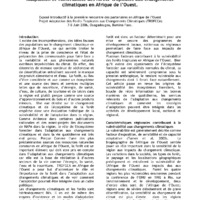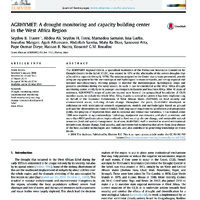Recherche
5 items
Acquis du CILSS dans le domaine de la recherche et de l’innovation
Dans leurs activités de recherche, les experts du CILSS sont impliqués dans plusieurs initiatives régionales et internationales dans lesquelles leurs contributions ont permis d’accroître la visibilité de l’institution et de la positionner aujourd’hui au cœur de plusieurs initiatives internationales sur la
sécurité alimentaire et les changements climatiques.
Les résultats de ces travaux ont été valorisés sous forme d’articles dans les revues scientifiques, de thèses de doctorat et de masters, de chapitres dans des ouvrages, de présentations à des conférences internationales ou de conférences débats.
Adaptation et vulnérabilité des forêts tropicales aux changements climatiques en Afrique de l’Ouest
Exposé introductif à la première rencontre des partenaires en Afrique de l’Ouest Projet Adaptation des Forêts Tropicales aux Changements Climatiques (TROFCCA) 7–8 Juin 2006, Ouagadougou, Burkina Faso.
Il existe des incompréhensions‚ des idées fausses des populations sur le changement climatique en Afrique de l’Ouest, ce qui semble limiter le niveau de la prise de conscience et l'état de préparation des communautés pour faire face a la variabilité et aux phénomènes naturels extrêmes imprévisibles du climat. En effet, des décennies de menace continue de sécheresse et de désertification entraînent souvent le manque de produit alimentaire et d'eau.
AGRHYMET: Adrought monitoring and capacity building center in the West Africa Region
The AGRHYMET Regional Center, a specialized institution of the Permanent Interstates Committee for Drought Control in the Sahel (CILSS), was created in 1974 at the aftermaths of the severe droughts that affected this region in the early 1970s. The mission assigned to the Center was to train personnel, provide adequate equipment for the meteorological and hydrological stations networks, and set up regional and national multidisciplinary working groups to monitor the meteorological, hydrological, crops and pastures conditions during the rainy season. As such, it can be considered as the West Africa drought monitoring center, similarly to its younger counterparts in Eastern and Southern Africa. After 40 years of existence, AGRHYMET’s scope of activities expend now beyond the geographical boundaries of CILSS member states, to include the whole West Africa thanks to several initiatives it has been implementing on behalf of the Economic Commission of West African States (ECOWAS) on food security and environmental issues, including climate change. Throughout the years, AGRHYMET developed, in collaboration with international research organizations, models and methodologies based on ground and satellite observations to monitor rainfall, food crop water requirements satisfaction and prospective yields, the progress of vegetation front and its seasonal and interannual variations. It has trained about 1200 new experts in agrometeorology, hydrology, equipment maintenance, and plant protection, and more than 6000 professionals on topics related to food security, climate change, and sustainable natural resources (land and water) management. As of now, AGRHYMET staff is involved in several international initiatives on climate change, food security, and environmental monitoring that allow them keep abreast of the best available technologies and methods, and also contribute to generating knowledge on those issues.
Annuaire des diplômés
De sa création à 2023, le CRA a formé 1 757 diplômés dont 909 Techniciens Supérieurs, 310 Ingénieurs et 538 Masters dans les domaines de la Sécurité Alimentaire et Nutritionnelle, la Gestion des Ressources Naturelles et la Maîtrise de l’Eau dans un contexte de changement climatique.Il a également participé au perfectionnement de plus de 9 000 cadres sahéliens et ressortissants d’autres régions d’Afrique. Le succès de ces formations constitue un réel motif de satisfaction pour le CILSS et ses partenaires, surtout que la demande de cette prestation dépasse l’espace sahélien pour toucher désormais d’autres pays de la CEDEAO, de l’Afrique Centrale et Australe.
What are the prospects for mobile livestock systems in the face of the densification of rural areas and climate change in West Africa?
The dynamics of livestock systems in sub-Saharan West Africa on the 2040 horizon will be determined more by current and expected societal changes than by climate change. Climate change is expected to result in increases in the concentration of carbon dioxide in the air, in temperatures in the warmer seasons, and in rainfall mainly due to more frequent and intense heavy storms. These increases are expected to favour crop production, but also runoff, soil erosion and flooding. The rapid and persistent increase in rural population density despite dramatic urbanisation is expected to fuel further expansion of cultivated lands and the reduction and fragmentation of rangelands, hampering pastoral mobility. This is likely to reduce the activity of seasonally mobile pastoral livestock farming, but also that of sedentary livestock farming deprived of rangelands and a source of competitively priced young animals. A policy that would advocate the end of seasonal regional transhumance in favour of ranching and stabling, would precipitate the decline of pastoral livestock and increase their fragility in the face of climatic and security risks. This change would require an investment that is beyond the reach of livestock breeders, who would be reduced to working for private investors or agro-industrial companies. The only policy that could sustainably support livestock systems in their diversity and complementarity would be resolute public investment by States and Regional Economic Communities (RECs) in the transformation and modernisation of pastoral mobility.
Access to pastoral resources and regional and local herd mobility should be secured by reaffirming the community or public status of water points and rangelands in hyper-arid zones, but also of non-cultivable land in wetter zones, as well as negotiated access rights to cultivated land after harvest. Frameworks for local and regional consultation should be established, and contractual agreements between pastoralists, agro-pastoralists and farmers should be facilitated. It is necessary to complete, rehabilitate and manage the hydraulic and veterinary infrastructures, the livestock passage corridors, the land reserved for grazing, the lodgings or enclosures for the livestock, with a view to creating a network of infrastructures adapted to the available forage resources, established in consultation with the livestock breeders' associations and the local authorities. A national and international commitment should overcome the civil insecurity that is rampant in many pastoral regions, along with significant investments in education, health, roads and telecommunications infrastructure that would ensure security and the adaptation of pastoral livestock farming to societal changes.


